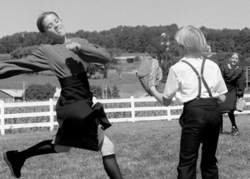Mennonites
(religion, spiritualism, and occult)Mennonites are the direct descendants of the Anabaptist movement (see Anabaptists) of the sixteenth century. Followers of the Swiss teacher Menno Simons (c. 1496-c. 1561),
from whom they got their name, they became an important religious force in the Netherlands and Germany, moved to the United States during colonial times, and eventually formed important communities in the prairie provinces of central and western Canada.
Like all denominations, they have suffered divisions over the years, the Amish being their most well known spiritual descendants.
Mennonites are considered to be conservative (see Evangelical) in theology. They practice the ritual of foot-washing, for instance, following the example and command of Jesus at the Last Supper (John 13). They require women to wear a head-covering during worship, following the advice of the apostle Paul (1 Corinthians 11:5). They forbid the taking of oaths, as in a court of law. Also forbidden is the holding of public office. They insist on plainness of dress and practice congregational polity. Each church is autonomous and calls its own minister.
One of the most important aspects of the Mennonite church is its peace witness. Along with Quakers and the Church of the Brethren, Mennonites are known for being pacifists. They forbid military service to their members, substituting civilian relief services overseen by the Mennonite Central Committee during times of war.
On any given Sunday, over one million Mennonites worldwide continue a 450-year-old worship tradition dating back to the time of the Protestant Reformation.
Mennonites
a Protestant sect that arose in Holland in the late 1530’s and early 1540’s as a result of the degeneration of revolutionary Anabaptism into a pacifist sect after the defeat of the Peasant War of 1524—26 and the Miinster Commune of 1534-35.
The name of the sect is linked with Menno Simons (died 1561), a Catholic clergyman who was converted to Anabaptism in 1531 and later reorganized remnants of the Anabaptist sect into a new congregation which was later called the congregation of Mennonites. The doctrines of the Mennonites are defined in the Declaration of the Chief Articles of Our General Christian Faith (1632). The Mennonites consider the most essential features of the Christian to be humility, rejection of violence (even if perpetrated for the common good), and moral self-perfection. They await the “second coming”and the “millennial reign”of Christ. They baptize only adults.
Mennonite communities are exclusive, and individuality is suppressed within them. Shunning modern civilization, the Mennonites adhere to a distinctly old-fashioned form of dress, hair-style, and way of life. From Holland the Mennonites migrated to many countries, including Russia, to which they came in the late 18th century as a result of the recruitment of colonists by Catherine II for settlement in the frontier lands; their numbers in the USSR are insignificant. The greatest number of adherents live in the USA, Canada, the Netherlands, and the Federal Republic of Germany. The total number of Mennonites does not exceed 300,000. The Mennonite World Conference, centered in Canada, has existed since 1930.
REFERENCES
Klibanov, A. I. Mennonity. Moscow-Leningrad, 1931.Krest’ianinov, V. F. Mennonity. Moscow, 1967.
Smith, C. G. The Story of the Mennonites, 3rd ed. Newton, 1950.
The Mennonite Encyclopedia, vols. 1-4. Hillsboro, 1955-59.
